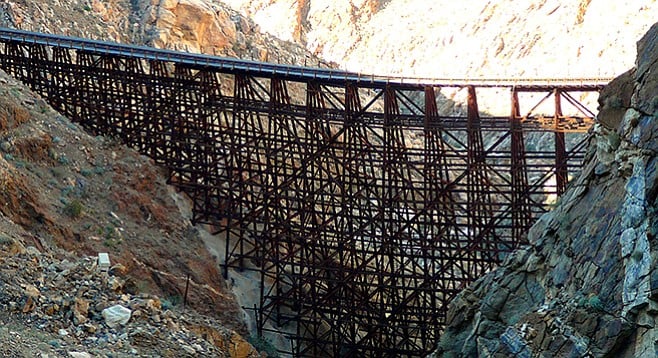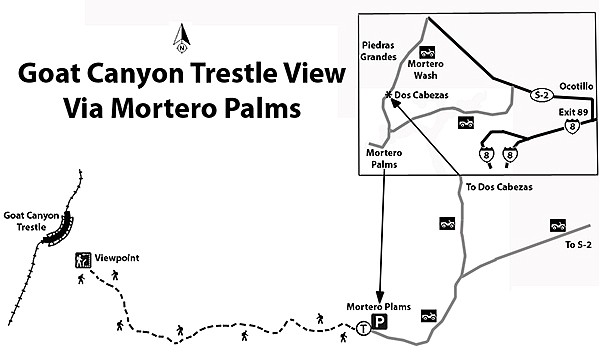 Facebook
Facebook
 X
X
 Instagram
Instagram
 TikTok
TikTok
 Youtube
Youtube

The trek to upper Goat Canyon is not a long hike but it is strenuous because of the rough terrain and boulder-hopping above Mortero Palms. The canyon’s name correctly implies that the nimbleness of a mountain goat is required for negotiating both a canyon and a trail named after this sure-footed animal. The “goat” in this case is the sure-footed desert bighorn sheep.

The goal of this hike is the Goat Canyon Trestle, named for the steep canyon spanned in Carrizo Gorge by the San Diego & Arizona Railway, the precursor to the San Diego & Arizona Eastern Railway. The trestle is one of the world’s highest woodpile trestle bridges, built from 157,000 linear feet of lumber and is perhaps the longest curved one, at 14 degrees of curvature.

According to SD&AE Railway records, “it was built of lumber instead of steel because variations in temperature of up to 75°F in a single day create problems of expansion and contraction that would result in metal fatigue had they used steel.” The trestle was completed in 1933 as part of a realignment of the original railroad route, completed in 1919, when Tunnel No. 15 collapsed due to earth slippage on March 27, 1932.

The Goat Canyon Trestle is 186 feet high and 597 feet long. Each section was built at the canyon bottom, then elevated by crane before being lowered into position. It is reported that some of the workers only stayed on the job three days before quitting because of the height and vertigo. The last train to cross Goat Trestle was in 1983. The trestle is accessible from Mortero Palms, Indian Hill, Carrizo Canyon, or a much more rugged and difficult route up Carrizo Gorge, although the tracks are legally off-limits to the public. There is no predicting whether the railroad route through Carrizo Gorge will be reopened or permanently closed due to the ongoing natural hazards and corporate uncertainties that have plagued the Impossible Railroad line since it opened almost a century ago. Regardless of these possibilities, it is illegal to hike or bike along the tracks or the right-of-way. Law-enforcement personnel will cite violators.
Access through Mortero Palms is the recommended hiking route to view the trestle. Mortero Palms is part of the Piedras Grandes Cultural Preserve. Over 100 palms are closely grouped and tucked in a canyon rimmed with brown and white granite. There is an intermittent small waterfall at the end of the grove. A few bedrock mortar holes are found within the grove, but the best ones, for which the canyon was named, are found about 300 feet down slope from the fronds. The water and palm grove were attractive not only to the Kumeyaay Indians who once inhabited this area but also to a local cattleman. Nearby you will find a cement trough inscribed “RD McCain Dec 1940.”
The route begins with the steep hike from the trailhead to Mortero Palms. Stay on the north side of the canyon as you work your way up to avoid some of the thick vegetation, and take care passing over dry waterfalls. Follow the canyon to the top, where there is a low ridge leading into a small flat valley (a good place for camping), just about a mile from the start of the hike. Take note of the excellent cactus specimens along the trail that include teddy-bear cholla and tall barrel cactus, plus the agave-covered hills. There are excellent desert views here before heading west and southwest over a small saddle into the Goat Canyon drainage that follows a use-trail. Hike to where there is an excellent overview of the trestle. Retrace your steps back to the trailhead.
Distance from downtown San Diego: About 104 miles (Mortero Palms). Allow 2 hours. Exit I-8 at Ocotillo via exit 89 and turn north to Ocotillo Drive, 9.1 miles west on SR-2, just past the Border Patrol checkpoint and the Imperial/San Diego County line and turn south on Mortero Wash — 4-wheel drive required. Set odometer to zero. Pass the Dos Cabezas railroad siding at 3.9 miles and cross the railroad tracks. Pass Piedras Grandes turnoff at 4.9 miles. Route continues straight ahead. At 5.2 miles, the Dos Cabezas Road enters from the left just before a second railroad-track crossing. Continue south to the turnoff to Mortero Palms, turning west, and drive up the valley 0.5 mile to the end of the road and the palm grove.
Hiking Length: 5.5 miles round-trip. Allow 5 hours.
Difficulty: Strenuous with an elevation gain/loss of 1500 feet.


The trek to upper Goat Canyon is not a long hike but it is strenuous because of the rough terrain and boulder-hopping above Mortero Palms. The canyon’s name correctly implies that the nimbleness of a mountain goat is required for negotiating both a canyon and a trail named after this sure-footed animal. The “goat” in this case is the sure-footed desert bighorn sheep.

The goal of this hike is the Goat Canyon Trestle, named for the steep canyon spanned in Carrizo Gorge by the San Diego & Arizona Railway, the precursor to the San Diego & Arizona Eastern Railway. The trestle is one of the world’s highest woodpile trestle bridges, built from 157,000 linear feet of lumber and is perhaps the longest curved one, at 14 degrees of curvature.

According to SD&AE Railway records, “it was built of lumber instead of steel because variations in temperature of up to 75°F in a single day create problems of expansion and contraction that would result in metal fatigue had they used steel.” The trestle was completed in 1933 as part of a realignment of the original railroad route, completed in 1919, when Tunnel No. 15 collapsed due to earth slippage on March 27, 1932.

The Goat Canyon Trestle is 186 feet high and 597 feet long. Each section was built at the canyon bottom, then elevated by crane before being lowered into position. It is reported that some of the workers only stayed on the job three days before quitting because of the height and vertigo. The last train to cross Goat Trestle was in 1983. The trestle is accessible from Mortero Palms, Indian Hill, Carrizo Canyon, or a much more rugged and difficult route up Carrizo Gorge, although the tracks are legally off-limits to the public. There is no predicting whether the railroad route through Carrizo Gorge will be reopened or permanently closed due to the ongoing natural hazards and corporate uncertainties that have plagued the Impossible Railroad line since it opened almost a century ago. Regardless of these possibilities, it is illegal to hike or bike along the tracks or the right-of-way. Law-enforcement personnel will cite violators.
Access through Mortero Palms is the recommended hiking route to view the trestle. Mortero Palms is part of the Piedras Grandes Cultural Preserve. Over 100 palms are closely grouped and tucked in a canyon rimmed with brown and white granite. There is an intermittent small waterfall at the end of the grove. A few bedrock mortar holes are found within the grove, but the best ones, for which the canyon was named, are found about 300 feet down slope from the fronds. The water and palm grove were attractive not only to the Kumeyaay Indians who once inhabited this area but also to a local cattleman. Nearby you will find a cement trough inscribed “RD McCain Dec 1940.”
The route begins with the steep hike from the trailhead to Mortero Palms. Stay on the north side of the canyon as you work your way up to avoid some of the thick vegetation, and take care passing over dry waterfalls. Follow the canyon to the top, where there is a low ridge leading into a small flat valley (a good place for camping), just about a mile from the start of the hike. Take note of the excellent cactus specimens along the trail that include teddy-bear cholla and tall barrel cactus, plus the agave-covered hills. There are excellent desert views here before heading west and southwest over a small saddle into the Goat Canyon drainage that follows a use-trail. Hike to where there is an excellent overview of the trestle. Retrace your steps back to the trailhead.
Distance from downtown San Diego: About 104 miles (Mortero Palms). Allow 2 hours. Exit I-8 at Ocotillo via exit 89 and turn north to Ocotillo Drive, 9.1 miles west on SR-2, just past the Border Patrol checkpoint and the Imperial/San Diego County line and turn south on Mortero Wash — 4-wheel drive required. Set odometer to zero. Pass the Dos Cabezas railroad siding at 3.9 miles and cross the railroad tracks. Pass Piedras Grandes turnoff at 4.9 miles. Route continues straight ahead. At 5.2 miles, the Dos Cabezas Road enters from the left just before a second railroad-track crossing. Continue south to the turnoff to Mortero Palms, turning west, and drive up the valley 0.5 mile to the end of the road and the palm grove.
Hiking Length: 5.5 miles round-trip. Allow 5 hours.
Difficulty: Strenuous with an elevation gain/loss of 1500 feet.
Comments